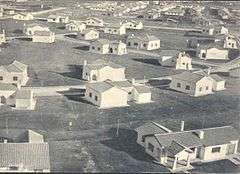Ciudad Evita
| Ciudad Evita | |
|---|---|
|
Ciudad Evita shortly after its inaugural | |
 Ciudad Evita Location in Greater Buenos Aires | |
| Coordinates: 34°43′S 58°32′W / 34.717°S 58.533°WCoordinates: 34°43′S 58°32′W / 34.717°S 58.533°W | |
| Country |
|
| Province |
|
| Partido | La Matanza |
| Founded | 1947 |
| Area | |
| • Total | 22.3 km2 (8.6 sq mi) |
| Elevation | 15 m (49 ft) |
| Population (2001 census [INDEC]) | |
| • Total | 68,650 |
| • Density | 3,100/km2 (8,000/sq mi) |
| CPA Base | B 1778 |
| Area code(s) | +54 11 |
Ciudad Evita (Evita City) is a city in La Matanza Partido, within the Greater Buenos Aires metro area. It currently has about 70,000 inhabitants, and is situated about 20 kilometers (13 mi) from Downtown Buenos Aires and 6 kilometers (4 mi) from Ministro Pistarini International Airport. The city has been declared a National Historic Monument of Argentina.[1]
The city owes its name to the Eva Perón Foundation, which developed the initial settlement. Established in 1947 by Argentine President Juan Perón, his Decree No. 33221 stipulated that this new suburb of Buenos Aires be named after the namesake of the foundation, his wife Eva (’Evita’) Duarte de Perón. The city, whose original 15,000 homes were designed in a simplified Spanish Colonial Revival style favored during the Perón era, featured a layout purposely built in the shape of Eva's profile, which seemingly waved to airline passengers from the nearby airport.[2] This overt homage to the influential first lady prompted the city's renaming as Ciudad General Belgrano following the military coup that deposed Perón in 1955.
Despite these changes, the town, which was administered by the National Mortgage Bank following the coup, continued to grow, incorporating the Barrio Vemme ward between 1960 and 1967. It was transferred to La Matanza Council in 1963, and upon the return of Peronists to power in 1973, it regained its Ciudad Evita designation. A second addition, Barrio Alas, was opened in 1974 for Argentine Air Force officers stationed at the Morón Air Base.
The March 1976 coup again led to a change of name for the town, to Ciudad General Martín Miguel de Güemes, until the return of democracy in 1983. The city was chosen that year as the site of the Buenos Aires Temple of The Church of Jesus Christ of Latter-day Saints (LDS Church), inaugurated in 1986.
Ciudad Evita was declared a National Historical Monument in 1997.
Notes and references
External links
- (Spanish) History of Ciudad Evita

